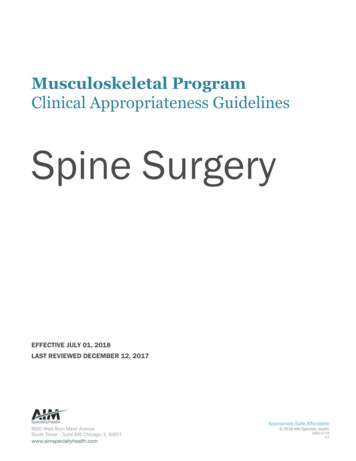
Transcription
Cover Spine Surgery GuidelinesMusculoskeletal ProgramClinical Appropriateness GuidelinesSpine SurgeryEFFECTIVE JULY 01, 2018LAST REVIEWED DECEMBER 12, 2017Appropriate.Safe.Affordable 2018 AIM Specialty Health2063-0718V.2
Table of ContentsDescription and Application of the Guidelines . 4Cervical Decompression With or Without Fusion . 5Description . 5Definitions . 6Criteria. 7Exclusions . 8Selected References . 9CPT Codes . 9History .11Cervical Disc Arthroplasty. 12Description .12Definitions .12Criteria.13Contraindications .13Exclusions .14Selected References .14CPT Codes .14History .15Lumbar Disc Arthroplasty . 16Description .16Definitions .16Criteria.17Contraindications .17Exclusions .18Selected References .18CPT Codes .18History .18Lumbar Discectomy, Foraminotomy, and Laminotomy . 19Description .19Definitions .19Criteria.20Exclusions .20Selected References .21CPT Codes .21History .21Lumbar Fusion and Treatment of Spinal Deformity (including Scoliosis and Kyphosis) . 22Description .22General Considerations.22Definitions .23Criteria.24Exclusions .26Copyright 2018. AIM Specialty Health. All Rights Reserved.Spine Surgery2
Selected References .26CPT Codes .27History .30Lumbar Laminectomy . 31Description .31Definitions .31Criteria.32Exclusions .32Selected References .32CPT Codes .33History .33Noninvasive Electrical Bone Growth Stimulation . 34Description .34Criteria.34Exclusions .35CPT/HCPCS Codes .35History .35Vertebroplasty/Kyphoplasty . 36Description .36Criteria.36Contraindications .37Exclusions .37Selected References .37CPT Codes .37History .38Bone Graft Substitutes and Bone Morphogenetic Proteins . 39Description .39Definitions .39Criteria.39Exclusions .40CPT Codes .40History .41Copyright 2018. AIM Specialty Health. All Rights Reserved.Spine Surgery3
Description and Application of the GuidelinesAIM’s Clinical Appropriateness Guidelines (hereinafter “AIM’s Clinical Appropriateness Guidelines” or the“Guidelines”) are designed to assist providers in making the most appropriate treatment decision for a specificclinical condition for an individual. As used by AIM, the Guidelines establish objective and evidence-based, wherepossible, criteria for medical necessity determinations. In the process, multiple functions are accomplished: To establish criteria for when services are medically necessaryTo assist the practitioner as an educational toolTo encourage standardization of medical practice patternsTo curtail the performance of inappropriate and/or duplicate servicesTo advocate for patient safety concernsTo enhance the quality of healthcareTo promote the most efficient and cost-effective use of servicesAIM’s guideline development process complies with applicable accreditation standards, including therequirement that the Guidelines be developed with involvement from appropriate providers with current clinicalexpertise relevant to the Guidelines under review and be based on the most up to date clinical principles andbest practices. Relevant citations are included in the “References” section attached to each Guideline. AIMreviews all of its Guidelines at least annually.AIM makes its Guidelines publicly available on its website twenty-four hours a day, seven days a week. Copiesof the AIM’s Clinical Appropriateness Guidelines are also available upon oral or written request. Although theGuidelines are publicly-available, AIM considers the Guidelines to be important, proprietary information of AIM,which cannot be sold, assigned, leased, licensed, reproduced or distributed without the written consent of AIM.AIM applies objective and evidence-based criteria and takes individual circumstances and the local deliverysystem into account when determining the medical appropriateness of health care services. The AIMGuidelines are just guidelines for the provision of specialty health services. These criteria are designed to guideboth providers and reviewers to the most appropriate services based on a patient’s unique circumstances. Inall cases, clinical judgment consistent with the standards of good medical practice should be used whenapplying the Guidelines. Guideline determinations are made based on the information provided at the time ofthe request. It is expected that medical necessity decisions may change as new information is provided orbased on unique aspects of the patient’s condition. The treating clinician has final authority and responsibilityfor treatment decisions regarding the care of the patient and for justifying and demonstrating the existence ofmedical necessity for the requested service. The Guidelines are not a substitute for the experience andjudgment of a physician or other health care professionals. Any clinician seeking to apply or consult theGuidelines is expected to use independent medical judgment in the context of individual clinical circumstancesto determine any patient’s care or treatment.The Guidelines do not address coverage, benefit or other plan specific issues. If requested by a health plan,AIM will review requests based on health plan medical policy/guidelines in lieu of the AIM’s Guidelines.The Guidelines may also be used by the health plan or by AIM for purposes of provider education, or to reviewthe medical necessity of services by any provider who has been notified of the need for medical necessityreview, due to billing practices or claims that are not consistent with other providers in terms of frequency orsome other manner.CPT (Current Procedural Terminology) is a registered trademark of the American Medical Association (AMA). CPT five digit codes,nomenclature and other data are copyright by the American Medical Association. All Rights Reserved. AMA does not directly or indirectlypractice medicine or dispense medical services. AMA assumes no liability for the data contained herein or not contained herein.Copyright 2018. AIM Specialty Health. All Rights Reserved.Spine Surgery4
Cervical Decompression With or WithoutFusionDescriptionCervical spine surgery is most commonly performed for radiculopathy or cervical myelopathy. Thegoal of surgery is adequate decompression of the nerve roots and/or spinal cord and stabilization ofthe spine.Cervical decompression is performed with or without a fusion procedure and may be broadly dividedinto anterior, posterior, or combined surgical approach. The choice of procedure depends on manyfactors including: Location of the compressionPresence of deformity or instabilityNumber of levels involvedPatient age and surgical fitnessLaminoplasty is a related procedure for achieving decompression without the need
Cervical spine surgery is most commonly performed for radiculopathy or cervical myelopathy. The goal of surgery is adequate decompression of the nerve roots and/or spinal cord and stabilization of the spine
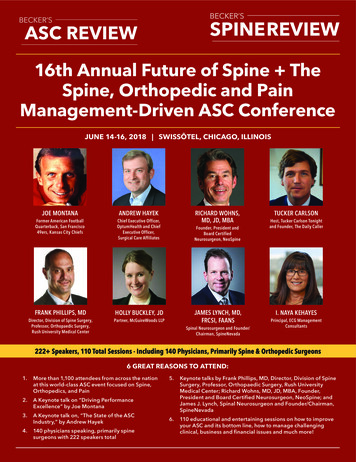
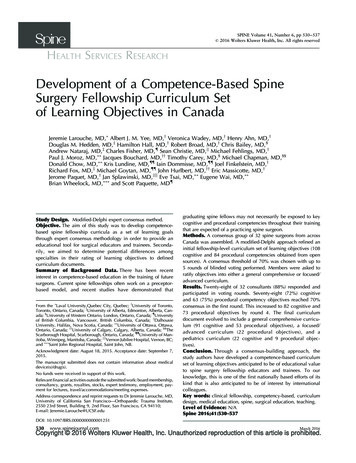
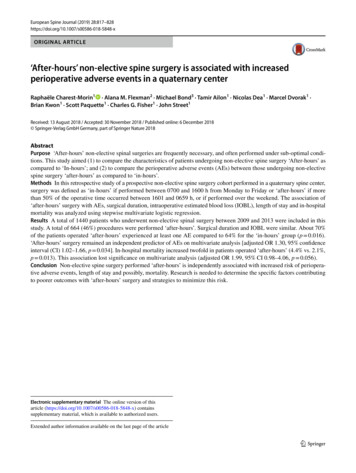

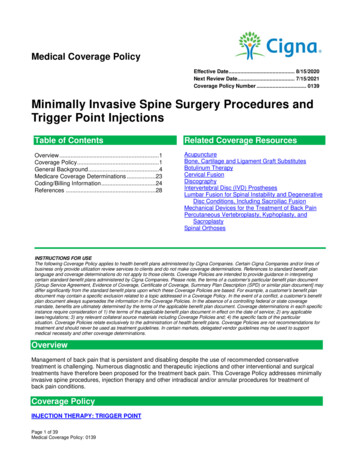
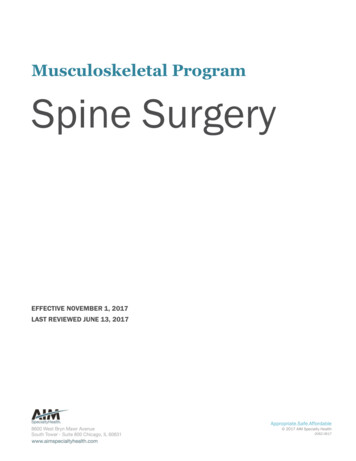



![[Page 1 – front cover] [Show cover CLEAN GET- AWAY 978-1 .](/img/13/9781984892973-6648.jpg)

